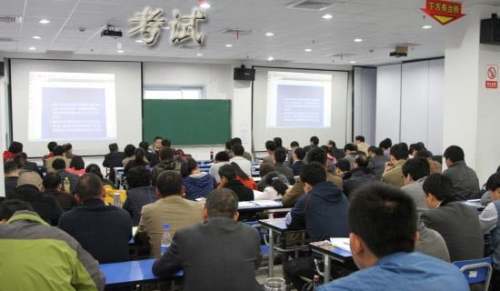- 相關(guān)推薦
歷年英語翻譯資格考試二級(jí)筆譯試題
英語翻譯資格考試是從事英語翻譯工作人員進(jìn)行的英語初級(jí)、中級(jí)、高級(jí)翻譯專業(yè)資格(水平)考試,下面,百分網(wǎng)小編為大家搜索整理了歷年英語翻譯資格考試二級(jí)筆譯試題,希望能給大家?guī)硎斋@,更多精彩內(nèi)容請(qǐng)及時(shí)關(guān)注我們應(yīng)屆畢業(yè)生考試網(wǎng)!

E-C Translation
Compulsory Translation
There was, last week, a glimmer of hope in the world food crisis. Expecting a bumper harvest, Ukraine relaxed restrictions on exports. Overnight, global wheat prices fell by 10 percent.
By contrast, traders in Bangkok quote rice prices around $1,000 a ton, up from $460 two months ago.
Such is the volatility of today’s markets. We do not know how high food prices might go, nor how far they could fall. But one thing is certain: We have gone from an era of plenty to one of scarcity. Experts agree that food prices are not likely to return to the levels the world had grown accustomed to any time soon.
Imagine the situation of those living on less than $1 a day - the “bottom billion,” the poorest of the world’s poor. Most live in Africa, and many might typically spend two-thirds of their income on food.
In Liberia last week, I heard how people have stopped purchasing imported rice by the bag. Instead, they increasingly buy it by the cup, because that’s all they can afford.
Traveling though West Africa, I found good reason for optimism. In Burkina Faso, I saw a government working to import drought resistant seeds and better manage scarce water supplies, helped by nations like Brazil. In Ivory Coast, we saw a women’s cooperative running a chicken farm set up with UN funds. The project generated income - and food - for villagers in ways that can easily be replicated.
Elsewhere, I saw yet another women’s group slowly expanding their local agricultural production, with UN help. Soon they will replace World Food Program rice with their own home-grown produce, sufficient to cover the needs of their school feeding program.
These are home-grown, grass-roots solutions for grass-roots problems - precisely the kind of solutions that Africa needs. optional
Topic 1
For a decade, metallurgists studying the hulk of the Titanic have argued that the storied ocean liner went down quickly after hitting an iceberg because the ship's builder used substandard rivets that popped their heads and let tons of icy seawater rush in. More than 1,500 people died.
Now a team of scientists has moved into deeper waters, uncovering evidence in the builder's own archives of a deadly mix of great ambition and use of low-quality iron that doomed the ship, which sank 96 years ago Tuesday.
The scientists found that the ship's builder, Harland and Wolff, in Belfast, struggled for years to obtain adequate supplies of rivets and riveters to build the world's three biggest ships at once: the Titanic and two sisters, Olympic and Britannic.
Each required three million rivets, and shortages peaked during Titanic's construction.
"The board was in crisis mode," said Jennifer Hooper McCarty, a member of the team that studied the company's archive and other evidence. "It was constant stress. Every meeting it was, 'There's problems with the rivets, and we need to hire more people.' "
The team collected other clues from 48 Titanic rivets, using modern tests, computer simulations, comparisons to century-old metals and careful documentation of what engineers and shipbuilders of the era considered state of the art.
The scientists say the troubles began when the colossal plans forced Harland and Wolff to reach beyond its usual suppliers of rivet iron and include smaller forges, as disclosed in company and British government papers. Small forges tended to have less skill and experience.
Adding to the threat, the company, in buying iron for Titanic's rivets, ordered No. 3 bar, known as "best," not No. 4, known as "best-best," the scientists found. They also discovered that shipbuilders of the day typically used No. 4 iron for anchors, chains and rivets.
So the liner, whose name was meant to be synonymous with opulence, in at least one instance relied on cheap materials.
The scientists argue that better rivets would have probably kept the Titanic afloat long enough for rescuers to have arrived before the icy plunge, saving hundreds of lives.
|||
C-E Translation
Compulsory Translation
“中國制造”模式遭遇發(fā)展瓶頸,這種模式必須要改進(jìn)和提高。一些外國人認(rèn)為,“中國制造”大約就是質(zhì)量低下的代名詞。不可否認(rèn),少數(shù)產(chǎn)品的確存在質(zhì)量問題,讓大多數(shù)價(jià)廉質(zhì)優(yōu)的產(chǎn)品代其受罪。
質(zhì)量是產(chǎn)品的生命線。隨著外國市場的夸大,中國企業(yè)也意識(shí)到質(zhì)量的重要性。因此一場旨在提高質(zhì)量,提供優(yōu)良服務(wù)的運(yùn)動(dòng)正在興起。
在傳統(tǒng)的制造業(yè)中,中國企業(yè)通過技術(shù)創(chuàng)新和質(zhì)量管理,為國際市場提供高質(zhì)量的產(chǎn)品。在新興的信息產(chǎn)業(yè),中國企業(yè)以高科技為師,增強(qiáng)和外國企業(yè)的交流與合作,提高產(chǎn)品質(zhì)量。
近幾年來,中國政府通過立法和社會(huì)監(jiān)督保證產(chǎn)品質(zhì)量,創(chuàng)造全社會(huì)重視產(chǎn)品問題的環(huán)境。
optional
Topic 1
1996年,一位攝影師在新疆喀納斯自然保護(hù)區(qū)無意間拍到一只白熊。自此以后的十年里,白熊藏身于深山之中,再無音訊。直到2003年,人們才再次在該自然區(qū)又發(fā)現(xiàn)了白熊的蹤跡。
在熊的家族里,只有北極熊是白色的。但是,這個(gè)龐然大物是如何離開極地寒帶,來到這個(gè)寒溫帶的地方呢?難道它是通過通往北極的水路來到此地?這一猜測遭到動(dòng)物學(xué)家的質(zhì)疑。首先,北極熊不能在溫帶的樹林中生活。其次,……
2006年,一個(gè)科學(xué)考察隊(duì)在白熊出沒的地區(qū)發(fā)現(xiàn)了熊冬眠的冬窩兒,還發(fā)現(xiàn)了一小團(tuán)白色的動(dòng)物毛發(fā)。DNA樣本鑒定為棕熊的毛發(fā)。但是,也有可能,至少那團(tuán)毛發(fā)不屬于照片中的白熊。
Topic 2
藍(lán)藻是一種簡單的水生植物,它可以在河湖、濕地、樹干和溫泉自然蔓延生長。當(dāng)藍(lán)藻細(xì)胞達(dá)到一定程度時(shí),藍(lán)藻的“密集孽生”會(huì)使水體變色、引起泡沫、散發(fā)臭氣、影響貝類和魚類的生存,還會(huì)使水質(zhì)大幅度下降。
2007年夏天,富營養(yǎng)物和其他污染導(dǎo)致藍(lán)藻在太湖、巢湖、滇池發(fā)生了藍(lán)藻“密集孽生”現(xiàn)象,影響了城市供水及水生產(chǎn)品生長。
“密集孽生”最嚴(yán)重的是太湖東部。太湖是我國第三大淡水湖。這次“密集孽生”導(dǎo)致周邊100多萬居民供水問題長達(dá)10天之久。為了防止污染,當(dāng)?shù)丨h(huán)保部門關(guān)閉了770家化工廠。
2008年夏天,長期的溫暖、干燥氣候?qū)е滤{(lán)藻在部分地區(qū)發(fā)生。9月,一艘可以快速、有效地清除藍(lán)藻的船在江蘇省投入使用。
【歷年英語翻譯資格考試二級(jí)筆譯試題】相關(guān)文章:
歷年英語翻譯資格考試筆譯三級(jí)真題06-18
職稱英語歷年真題試題09-26
歷年證券從業(yè)資格考試真題及答案09-26
四六級(jí)英語翻譯試題06-12
二級(jí)Access試題及答案10-25
職稱英語歷年真題《衛(wèi)生A》試題09-25
從業(yè)資格考試模擬試題07-03